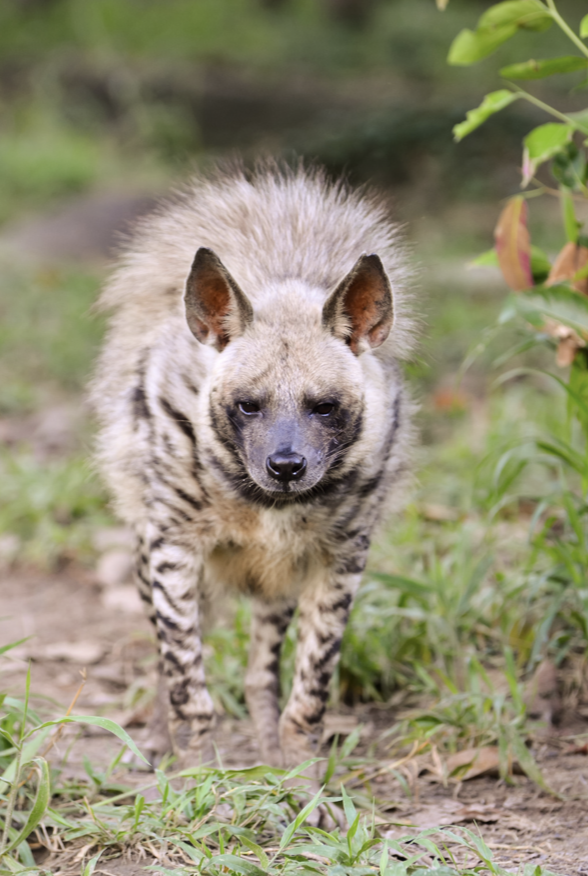Striped Hyena
Species in Peril:
Striped Hyenas

The most isolated and rarest of hyenas
Their range
The historical range of the striped hyena included Africa north of and including the Sahel zone, eastern Africa south into Tanzania, the Arabian Peninsula and the Middle East up to the Mediterranean Sea, Turkey, Iraq, the Caucasus (Azerbaijan, Armenia, Georgia), Iran, Turkmenistan, Uzbekistan, Tajikistan, Afghanistan (except the Hindukush) and the Indian Subcontinent.
In most regions, the species’ distribution is patchy today, indicating that it exists in many isolated populations, particularly in most of West Africa, most of the Sahara, sections of the Middle East, the Caucasus, and central Asia.
It does, however, have a wide range of distribution over Ethiopia, Kenya, and Tanzania. Its current distribution in Pakistan, Iran, and Afghanistan is uncertain, but it is thought to exist in huge numbers in open parts of India’s Deccan Peninsula. Periodic sightings were recorded in Kandahar Province during the current Afghanistan battle, though not conclusively.
Their social lives
The striped hyena is predominantly a nocturnal species, leaving its den only when total darkness falls and returning before daylight. Striped hyenas are usually found alone or in pairs, though in Libya, groups of up to seven animals have been observed.
They are not typically territorial animals, and the home ranges of different groups frequently overlap. The Serengeti’s home ranges range from 17 sq mi to 28 sq mi, whereas the Negev’s home range is 24 sq mi). When marking their territory, striped hyenas use the paste of their anal pouch (hyena butter) to scent mark grass, stalks, stones, tree trunks and other objects. The black patch near the thoracic and lumbar vertebrae is erected during aggressive confrontations. Striped hyenas bite at the throat and legs when fighting, but not at the mane, which functions as a signaling system.
They kiss each other’s mid-back regions, sniff each other’s noses, extrude their anal pouches, or claw each other’s throats when welcoming each other.
The species is not as vocal as the spotted hyena, with only a chattering chuckle and howling as vocalizations.
Unique fur
For an animal of its size, the winter coat is extraordinarily long and consistent, with a luxuriant mane of stiff, long hairs running down the back from the occiput to the base of the tail. The coat is coarse and bristly in general, though this changes depending on the season. The coat is dense, velvety, and has well-developed
underfur in the winter. The guard hairs on the flanks are 50–75 mm long, the mane is 150–225 mm long, and the tail is 150 mm long. The coat is significantly shorter and coarser in the summer, and there is no underfur, however the mane remains enormous. The coat is usually filthy-brownish grey or dirty grey in the winter. The mane has light grey or white hairs at the base and black or dark brown hairs at the tips. While the muzzle is dark, greyish brown, brownish-grey, or black, the top of the head and cheeks are lighter in color. The ears are nearly black in color. On the front of the neck, there is a huge black mark separated from the chin by a light zone. From the flanks to the back of the cheeks, a black field ascends. Small dark patches and transverse stripes cover the inner and outer surfaces of the forelegs.
A Few More Facts About striped hyenas
- Only extant species in the genus Hyaena.
- Striped hyenas are the national animal of Lebanon.
- Striped hyenas can raise their hair to make it look over 30 percent larger.
- They have great night vision allowing them to see in the dark.
- Although they look like dogs, they are actually more like cats.
- They are considered to be very intelligent.
- They don’t need to drink a lot of water and can go days without water if needed.
Species Name
Hyaena hyaena
Estimated Population
5,000 to 14,000
Conservation Status
Near Threatened
Range
North and East Africa, the Middle East, the Caucasus, Central Asia and the Indian subcontinent.
Reasons for Population Decline
Habitat destruction
Overhunting
Human encroachment on their habitat


